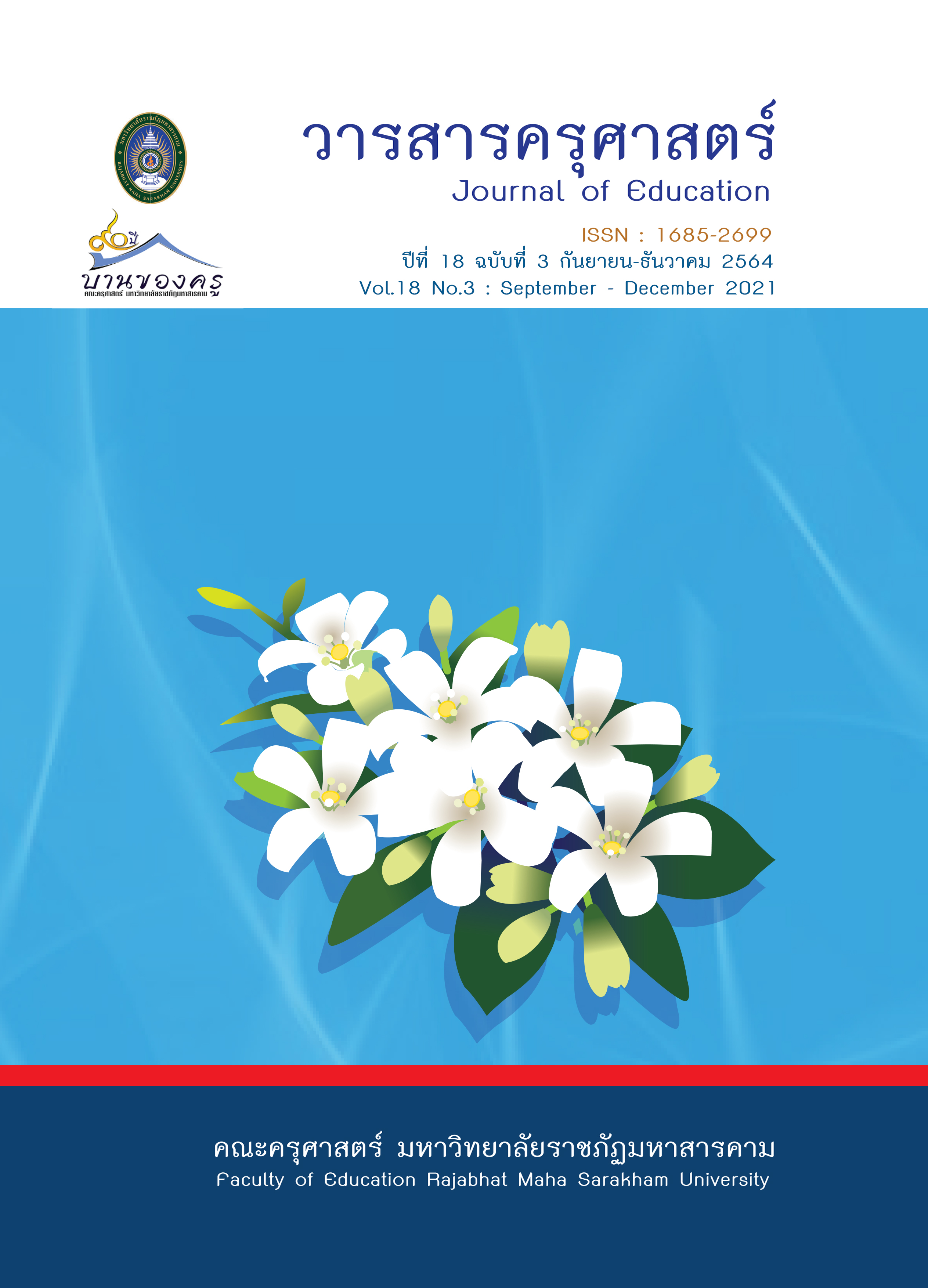A Learning Model to Promote Creative Productivity Thinking in the Ubiquitous Learning Environment for Undergraduate Students
Main Article Content
Abstract
The purposes of this research were to: 1) develop a learning model that promoted creative productivity thinking in the ubiquitous learning environment for undergraduate students and 2) assess such developed model in the ubiquitous learning environment for undergraduate students. The research was conducted with mixed methods. The sample groups using the purposive sampling technique were: 1) 9 experts in designing the ubiquitous learning environment, creative productivity thinking, educational media and innovation, and measurement and evaluation and 2) 5 qualified scholars in learning management, measurement and evaluation, educational media and innovation, and creative productivity thinking. The data were collected by an in-depth interview and an evaluation form of the learning model. The data were analyzed by content analysis, percentage, mean, and standard deviation. The findings indicated that the result of development the learning model consisted of 4 components including 1) overall principles and concepts of the learning model, 2) objectives of the learning model, 3) a learning process, and 4) measurement and evaluation. Furthermore, the results revealed that the suitability of the learning model was at the most appropriate level.
Article Details

This work is licensed under a Creative Commons Attribution-NonCommercial-NoDerivatives 4.0 International License.
ข้อกำหนดเบื้องต้นที่ผู้นิพนธ์(ผู้ส่งบทความ) ควรทราบ
1. ผู้นิพนธ์ที่ประสงค์จะลงตีพิมพ์บทความกับวารสาร ตั้งแต่เดือนมกราคม 2563 เป็นต้นไป ให้ใช้รูปแบบใหม่ (Template 2563) โดยสามารถดูตัวอย่างได้ที่เมนู GUIDELINES
2. จะตีพิมพ์และเผยแพร่ได้ ต้องผ่านการประเมินจากผู้ทรงคุณวุฒิ (Peer Review)
3. การประเมินบทความโดยผู้ทรงคุณวุฒิ (Peer Review) เป็นแบบ Double Blind
4. การอ้างอิงบทความใช้หลักเกณฑ์ APA (American Psychological Association) คลิก
5. บทความถูกปฏิเสธการตีพิมพ์ ไม่ผ่านการประเมิน ผู้นิพนธ์ขอยกเลิกเองหรือชำระเงินก่อนได้รับการอนุมัติ ทางวารสารไม่มีนโยบายการคืนเงิน
References
กรมวิชาการ, กระทรวงศึกษาธิการ. (2545). หลักสูตรการศึกษาขั้นพื้นฐาน พุทธศักราช 2545. องคการรับสงสินค้าและพัสดุภัณฑ (ร.ส.พ.).
จิรัฏฐ์ สวัสดิพัชรกุล. (2560). ผลการใช้รูปแบบการเรียนการสอนตามแนวคอนสตรัคชั่นนิซึ่มเพื่อพัฒนาความคิดสร้างสรรค์ของนักศึกษาอาชีวะเกษตรของไทย. วารสารวิชาการครุศาสตร์อุตสาหกรรมพระจอมเกล้า พระนครเหนือ. 8(1) 231-240.
ทนันยา คำคุ้ม. (2560). การพัฒนารูปแบบการเรียนการสอนเชิงผลิตภาพ เพื่อพัฒนาทักษะการสร้างนวัตกรรมการศึกษา สำหรับนักศึกษาระดับปริญญาตรี คณะครุศาสตร์ มหาวิทยาลัยราชภัฏกลุ่มภาคตะวันออกเฉียงเหนือ. {วิทยานิพนธ์ปริญญาดุษฎีบัณฑิต ไม่ได้ตีพิมพ์]. มหาวิทยาลัยมหาสารคาม.
ทิศนา แขมณี. (2555). ศาสตรการสอน: องคความรูเพื่อการจัดกระบวนการเรียนรูที่มีประสิทธิภาพ. สำนักพิมพ์แห่งจุฬาลงกรณมหาวิทยาลัย.
พระราชบัญญัติการศึกษาแห่งชาติ (ฉบับที่ 4) พ.ศ. 2562. (2562, 1 พฤษภาคม). ราชกิจจานุเบกษา. เล่มที่ 136 ตอนที่ 57 ก. หน้า 49-53.
ไพฑูรย์ สินลารัตน. (2559). การศึกษาไทย 4.0 : ปรัชญาการศึกษาเชิงสรางสรรคและผลิตภาพ. โรงพิมพ์แหงจุฬาลงกรณมหาวิทยาลัย.
บุญชม ศรีสะอาด. (2541).วิธีการทางสถิติสำหรับการวิจัย. สุวีริยาสาส์น.
Brown, James W. and Lewis (1973). AV. Instruction Technology, Media and Methods. 4 th ed. New York: McGraw – Hill Book Company.
Eggen, P. D. and Kauchak, D. P. (2006). Strategies and Models for Teachers: Teaching content and thinking Skills. Boston: Pearson.
Joe Luca and Ron Oliver. (2004). Supporting Teamwork and Collaboration with Online Technologies. World Conference on Educational Media and Technology, pp. 1460–1467.
Joyce B. and Weil M. (1996). Models of Teaching. 5 th ed. Allyn and Bacon.
Maraviglia, R. L., and Kvashny, A. (2006). Managing Virtual Changes-A Guide to Creative Problem-solving in the Design Professions. Author House.
Meyer, Paul L. (2015). SMI: Success motivation. Retrieved from http://www.success-motivation.com/index.php?Option= com_content&view=article&=25.
Torrance. E.P. (1962). Guiding Creativie Talent. Prentice Hall. Retrieved from http://dx.doi.org/10.1037/13134-000
Treffinger, J.D., Isaksen, G. S., and Dorval, K. B. (2003). Creative problem solving (Cps version 6.1) A contemporary framework for managing change. Journal of Creative Problem Solving Group.
Retrieved from htt//cps.com.
Tseng, S. (2010). The Correlation between Organizational Culture and Knowledge Conversion on Corporate Performance. Journal of Knowledge Management, 14, 269-284.
Oldham, E., A. FitzGibbon, and K. Johnston. (2005). Ubiquitous devices a preparation for student-teachers' use oftechnology for teaching and learning. In Society for Information Technology and Teacher Education International Conference.
Tseng, G., Wu, C.H., and Hwang, G. (2010). A Collaborative Ubiquitous Learning Approach for Conducting Personal ComputerAssembling Activities. In International Conference on Advanced Learning Technologies, pp.726-727.


